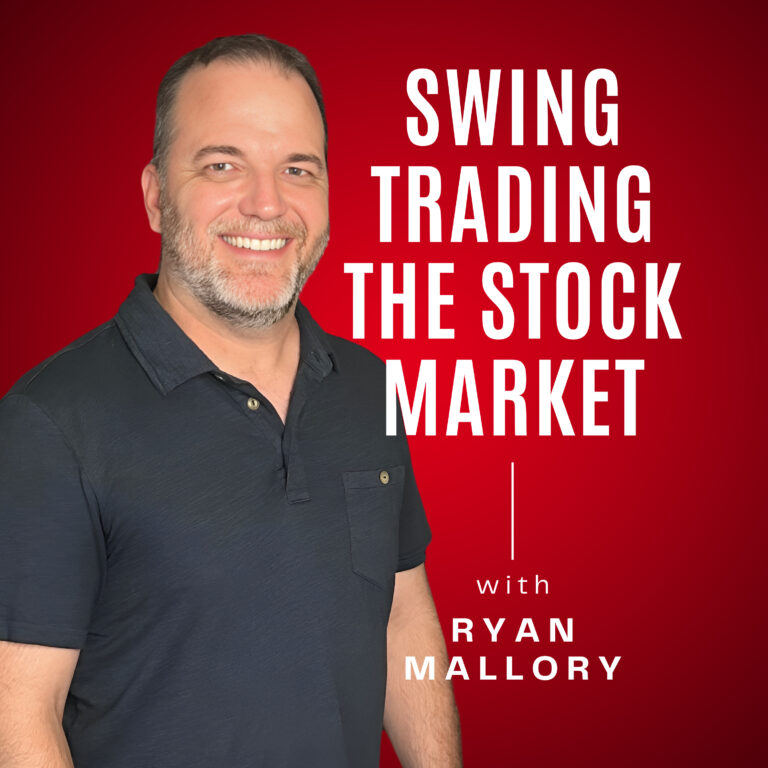Episode Overview
In this podcast episode, Ryan covers the topic of averaging into your winning trades. Is this a viable strategy that maximizes profits, or does it expand the risk factor at the expense of reward?
Available on: Apple Podcasts | Spotify | Amazon | YouTube
Episode Highlights & Timestamps
- [0:00] Averaging Into Winners
Ryan introduces the topic and explains how even winning trades can turn into losers when you average in. - [1:14] Skeeter’s Question from London
A listener from London asks whether Ryan ever increases his position size as a trade starts moving in his favor. - [2:51] Why It Doesn’t Work for Ryan
Ryan explains why he avoids scaling into trades and opts for full position sizes upfront. - [3:53] Impact on Reward/Risk Ratio
Breaks down how adding to winners can skew the reward-to-risk ratio and why that makes trades less favorable. - [10:22] Emotional and Strategic Drawbacks
Discusses the emotional toll and increased vulnerability to reversals when averaging up a position.
Key Takeaways from This Episode:
- Averaging Up Skews Risk/Reward: Adding to a winning position increases your entry average, decreasing the potential reward while increasing risk.
- Go All In from the Start: Ryan prefers full position sizing at the outset (e.g., 16%) rather than piecing in trades over time.
- Emotional Discipline Matters: Scaling in often stems from fear or discomfort with initial size. Address position sizing instead.
- Reversals Hurt More When Averaged Up: In volatile markets, price reversals are common and more damaging if you’ve scaled up your position.
- Your Best Trades Deserve Full Exposure: Waiting to scale in may result in underexposure to your highest-performing trades.
Resources & Links Mentioned:
- Swing Trading the Stock Market – Daily market analysis, trade setups, and insights by Ryan Mallory.
- Join the SharePlanner Trading Block – Get real-time trade alerts and community support.

Take the Next Step:
✅ Stay Connected: Subscribe to Ryan’s newsletter to get free access to Ryan’s Swing Trading Resource Library, along with receiving actionable swing trading strategies and risk management tips delivered straight to your inbox.
📈 Level Up Your Trading: Ready for structured training? Enroll in Ryan’s Swing Trading Mastery Course, The Self-Made Trader, and get the complete trading course, from the foundational elements of trading to advanced setups and profitable strategies.
📲 Join the Trading Community: Sign up for SharePlanner’s Trading Block to become part of Ryan’s swing-trading community, which includes all of Ryan’s real-time swing trades and live market analysis.
Full Episode Transcript
Click here to read the full transcript
0:00
Hey, everybody. This is Ryan Mallory with shareplanner.com’s
0:02
Swing Trading the Stock Market. In today’s episode, we’re going to talk about averaging into your winners.
0:06
And the thing about averaging into your winners is sometimes they don’t always stay winners. They can turn into losers as well.
0:12
So we’re going to talk a little bit about that in this podcast episode. Today’s episode, though, comes from a person over in London on the other side of the pond.
0:21
And I don’t ever use their real names because I don’t want them to regret, you know, in five, 10-15 years that I use their real name.
0:27
So I always give them a good Florida redneck name. And in this case, Skeeter.
0:29
I like the name Skeeter because it’s a name that I if I had a fourth kid, I’d always want to name him Skeeter.
0:35
If it was a girl, Skeeter, Rita, so, so many folks that it not from the South listening to this, probably the guy that wrote this e-mail.
0:44
He’s like, what in the world did I just write into? But nonetheless, you’re getting a Florida redneck name.
0:50
Skeeter it is. And Skeeter writes, Hey, Ryan, really enjoy the podcast.
0:56
Thank you for your time and wisdom. You talk about letting your winners run, but you ever add to a winning position once you see the
1:02
market is doing what you had hoped it would do, that is increase your position once it begins to trend in your favor.
1:09
Listening here from London, the real one where you don’t have to say anything after it. Thanks, Skeeter.
1:14
OK, lots of good questions there in this particular podcast, all surrounding whether or not you should average into your winners.
1:22
Now, I’d never consider myself to be the ultimate authority on anything in this world. I I just don’t, I’m, I’m a human being prone to being wrong a lot, being fallible quite a bit.
1:38
So for me to say, oh, you should never, ever, ever average into your winners, there’s nowhere averaging into your winners works would be wrong for me to say that because I’m sure there’s plenty
1:48
of people out there that have been successful trading that average into their winners. Now, does it work for me?
1:53
No. And I’m going to give you a lot of those reasons for why it doesn’t work for me.
1:59
One of the things though, I would say where it can work is that if you’re building a position over time, like from a long term investment perspective, you really can’t even avoid it.
2:07
For instance, like when I buy a a stock for the long term, I’m not buying all at once because I’m not trying to time the bottom.
2:13
I’m not trying to determine where the lowest price is going to be before I get in. Instead, I want to average it out over the like 4 to 6 months.
2:22
That’s different than swing trading where your trades are going to be like from a few days to a few weeks.
2:28
When it comes to long term investing, I don’t know where that bottom is. I don’t I don’t know what it’s going to be doing in four to six months.
2:34
So I want to average in my price over the course of many months. And so that’s going to require that I’m buying above where I initially at, bought in at and where
2:43
I’m buying in below where I initially bought in at. So and long term investing, yeah, I think it’s fine, but not so much from a swing trading
2:51
perspective or so at least the way that I’ve experienced it, it’s not always been good. And so for me, swing trading requires that I go all in on the trade, not all in from like I’m
3:03
putting every dime that I have in my account on the trade, whatever my predetermined position size for that trade is going to be.
3:09
And in my case, it’s about 16%. I’m going to make sure that I’m going 16% in.
3:19
I’m not going like 8% now, 8% later, 4% now, 4% down another week later it’s over. I’m not going to just like keep adding to it over time.
3:28
It’s different than the way I get out of a trade. Whereas when I’m when the stock does start going out of going in my favor, I start taking partial
3:35
profits. But when I’m getting into the trade, it’s all at once.
3:40
So the big thing that you want to remember that when it comes to getting into a stock and then you’re adding to it as it goes more in your favor is that you’re actually increasing the risk and
3:53
decreasing the reward. And what do I mean by that is that your average buying price is skewing the reward risk ratio more
4:02
in the favor of risk. If you’re buying it at 100, for instance, OK, you buy stock ABC at 100 and you have a stop loss at
4:11
95 and you think that there is a target area that you want to go after at 110. Well then that’s great.
4:21
That’s 2 to one. But but if you add another, you know equal lot at 102.
4:27
So let’s say you buy a third of your total position size at 100, then you buy another third at 102. Now your average price is at one O one.
4:35
That means you have $6 of of potential risk to the downside and you have $9 of potential reward to the upside.
4:44
Just that $1.00 shift is taking it from a 2 to one return to a three to two potential return. So the reward risk ratio has been greatly impacted there.
4:52
Now if you go to, let’s say I’m going to add another third at one O 4, then your average buying price is at one O 2.
5:00
That means you now have $7.00 of risk and you have $8 of reward. So now you have an 8 to 7 reward risk ratio.
5:11
You’re barely above 1 to one. That is not an ideal place to be and your trade and it makes it really to where it’s not a favorable
5:19
trade setup at all. Now, you could, you know, target like a three to one return, but then you’re requiring and expecting
5:24
more out of the market than what the market might be able to give from a realistic standpoint. And if you’re in a very choppy market, it’s going to be next to impossible because in a choppy
5:32
market, you’re probably going to be getting in just when you should be getting out. You’re, you’re coming into a full position when you should be taking profits.
5:41
So that’s, that’s the problem really with trying to play your trades from a standpoint of adding incrementally to your position.
5:53
Now, sometimes I have found that when people are doing that is that they’re trading with too big a position sizes to begin with.
5:59
They’re they’re trying to say this, I want to trade big, but I don’t want to do it all at once because emotionally they can’t handle it.
6:06
So they’re trying to wait for it to become to a point to where they have a little bit of profits in the bag in terms of like, OK, they bought it 100, they’re at one O 2 now they got 2% in profits.
6:17
I’m going to go ahead and add another third of my position there. But the reason why they’re doing it in the first place is probably because they’re trading too big
6:23
of a position size. If they found their true position size, they’d probably be more comfortable with getting all in at
6:29
at once. And again, I’m not saying go 100% long.
6:31
I’m saying whatever your position size is set out for an individual trade, whether it’s this trade or next trade, it should be really for any and all trades.
6:40
Then if you’re trading within the right position size, it’s probably not going to be as big of a
6:50
problem or a big, big of step of faith to be able to do that.
6:50
So the other question would be then why don’t you just average down then? And because in that, in that way you’re, you’re then working with decreasing your, your average buy
7:02
in price. And that doesn’t sound bad on the surface because, because let’s say you go and by by averaging in
7:11
when you get in at 100 and you, you average in and now you’re buying prices at 99. Well, great.
7:15
Now your risk is only $4.00 to the downside and $11.00 to the upside. You almost made it a three to one return at this point.
7:23
That sounds good. But the problem is, is that your best trades, your best setups to where it does exactly what it’s
7:30
supposed to do. It’s going to leave you in the dust with like 1/3 or 1/2 position.
7:34
You’re not going to be able to get a full position on it. And so that’s going to leave you frustrated as a trader, like, oh, I wish I could have gotten more
7:39
of it because you were trying to average end at a lower price. And then when it doesn’t go lower and it actually does remarkably well for you exactly the way you
7:50
had charted it out, you’re going to be left frustrated ’cause you’re like, I didn’t even get a big position.
7:56
And then the trades that you do get stopped out on are going to be on full positions. So I’m not a fan.
8:01
And I can’t really justify on from a swing trading standpoint, averaging into your winners or averaging into the losers because in both cases it throws off the equation.
8:12
That’s why I’m a person who only puts all of my money in all at the same time. If I, like I said I I trade about 16% position sizes.
8:21
When I get long, I’m getting along that entire amount. I’m not averaging in.
8:26
I’m not, I’m not averaging up. I’m not averaging down and before I get to 1 of the next big issues, I would encourage you to check
8:33
out swingtradingthestockmarket.com. That’s going to take you to my SharePlanner page.
8:37
And there you can see all the different product offerings and services that I that ioffer through this podcast.
8:43
And in doing so, by signing up, you’re going to get all my stock market research. You can even level up and get get my actual trades that I’m taking on a daily basis, my watch list
8:52
and all that good stuff. Check it out swingtradingthestockmarket.com.
8:55
I’m going to give you a lot of good videos throughout the day from watch list reviews, daily watch list, big tech updates, stock market updates.
9:04
It’s a really, really good service. Really good feature.
9:06
There’s a Discord as well on the trading block, so check that out. swingtradingthestockmarket.com.
9:12
Now one of the big issues of averaging into your winners, let’s say, again, let’s forget about the reward risk ratio.
9:19
Let’s say you bought in at 100, and then you get into 102, and then you get into 104. So now your average buying price instead of the original 100, it’s at 102.
9:29
It can lead to some pretty substantial reversals. And that could be even more frustrating because especially in a market like what we’re trading in
9:36
right now, the, the, the potential for reversals everyday looms very large, both to the upside and to the downside.
9:41
No matter what direction you’re trading in, you can get hit with a reversal because there’s so much headline risk in this market with all the tariffs and everything else that’s going on, it is very
9:51
easy for that to take to happen. And so if you’re increasing into it, you are increasing the odds of you losing because you’re
9:58
increasing your basis, your price basis. So if it goes from 100 to 102, it’s more likely that it’s going to close a below 102 than it would
10:06
below 100. And if it has a full on reversal or it takes you out at your original stop loss, then you’re taking
10:13
on a substantially bigger risk or a bigger loss than if you had never averaged in the 1st place and you had just gotten all in at that $100 price mark.
10:22
So you are more prone and more vulnerable by the repercussions of reversal by averaging into your winners.
10:31
Now here’s the other kicker to all of this. When you’re averaging in, your best trades are going to be with reduced rewards because you’re going
10:39
to be averaging up your buying price. So instead of getting in at 100, you’re getting in at 102 and 104 with the average price of 102.
10:47
So your best reward or your best trades are going to have smaller rewards because you averaged higher.
10:54
And then your worst trades are going to have bigger losses because you have a higher basis price, you’re going to have smaller reward.
11:02
Not only that, but you’re also going to have bigger risk. And so when the trades go against you, especially after you have a full position, you’re going to
11:09
have a much bigger loss. So your best trades are going to have smaller reward and your worst trades are going to have bigger
11:15
risk. And that can be emotionally damaging.
11:18
And I stress so much on this podcast how important it is to, to, to manage the emotional capital that you have because there’s nothing worse than getting down on yourself questioning whether or not
11:31
you can do this because you’re putting yourself into positions that are, are there are no win scenarios.
11:37
And so we have to be able to preserve our, our mental makeup and all of our trades. So we have to make sure that even though what we think might result in a winning trade, if it’s not
11:49
scalable, if it’s not sustainable and if it’s not something that can lead to a winning strategy over time, regardless if you how sure you are about this individual trade in the short term, it’s not
11:59
worth it. Managing your mental capital is huge and I’m and I fear averaging into your winners is going to
12:06
again decrease the amount of reward that you could potentially have on your best trades while increasing the the losses on your worst trades.
12:16
If you enjoy this podcast episode, I would encourage you to like and subscribe if you’re listening to me on YouTube and if you’re listening to me on Spotify or, or Apple or or the myriad of other
12:26
podcast platforms that are out there, leave me a five star review. I would greatly appreciate that.
12:31
I I do read all the reviews and they do mean a lot to me. And don’t forget as well to keep sending me your question ryan@shareplanner.com.
12:37
I read every single e-mail and most of the time I can make a podcast episode out of it because not enough of you write the show.
12:44
So keep writing the show. Send me your questions and I’d love to make an episode out of it.
12:48
Thank you guys, and God bless. Thanks for listening to my podcast, Swing Trading the Stock Market.
12:54
I’d like to encourage you to join me in the SharePlanner Trading Block where I navigate the stock market each day with traders from around the world.
13:02
With your membership, you will get a seven day trial and access to my trading room including alerts via text, e-mail and WhatsApp.
13:08
So go ahead, sign up by going to shareplanner.com/trading Block. That’s www.shareplanner.com/trading-block and follow me on SharePlanners Twitter, Instagram and
13:19
Facebook where I provide unique market and trading information every day. You have any questions, please feel free to e-mail me at ryan@shareplanner.com.
13:29
All the best to you and I look forward to trading with you soon.
Enjoy this episode? Please leave a 5-star review and share your feedback! It helps others find the podcast and enables Ryan to produce more content that benefits the trading community.
Have a question or story to share? Email Ryan and your experience could be featured in an upcoming episode!
Become part of the Trading Block and get my trades, and learn how I manage them for consistent profits. With your subscription you will get my real-time trade setups via Discord and email, as well as become part of an incredibly helpful and knowledgeable community of traders to grow and learn with. If you’re not sure it is for you, don’t worry, because you get a Free 7-Day Trial. So Sign Up Today!

Welcome to Swing Trading the Stock Market Podcast!
I want you to become a better trader, and you know what? You absolutely can!
Commit these three rules to memory and to your trading:
#1: Manage the RISK ALWAYS!
#2: Keep the Losses Small
#3: Do #1 & #2 and the profits will take care of themselves.
That’s right, successful swing-trading is about managing the risk, and with Swing Trading the Stock Market podcast, I encourage you to email me (ryan@shareplanner.com) your questions, and there’s a good chance I’ll make a future podcast out of your stock market related question.
In today's episode, I cover the expectations that we should be setting for ourselves as swing traders, from the number of trades we should be expecting to take, how long and how short we should be in our trading portfolio, as well as what the expectations for a win-rate should be.
Be sure to check out my Swing-Trading offering through SharePlanner that goes hand-in-hand with my podcast, offering all of the research, charts and technical analysis on the stock market and individual stocks, not to mention my personal watch-lists, reviews and regular updates on the most popular stocks, including the all-important big tech stocks. Check it out now at: https://www.shareplanner.com/premium-plans
📈 START SWING-TRADING WITH ME! 📈
Click here to subscribe: https://shareplanner.com/tradingblock
— — — — — — — — —
💻 STOCK MARKET TRAINING COURSES 💻
Click here for all of my training courses: https://www.shareplanner.com/trading-academy
– The A-Z of the Self-Made Trader –https://www.shareplanner.com/the-a-z-of-the-self-made-trader
– The Winning Watch-List — https://www.shareplanner.com/winning-watchlist
– Patterns to Profits — https://www.shareplanner.com/patterns-to-profits
– Get 1-on-1 Coaching — https://www.shareplanner.com/coaching
— — — — — — — — —
❤️ SUBSCRIBE TO MY YOUTUBE CHANNEL 📺
Click here to subscribe: https://www.youtube.com/shareplanner?sub_confirmation=1
🎧 LISTEN TO MY PODCAST 🎵
Click here to listen to my podcast: https://open.spotify.com/show/5Nn7MhTB9HJSyQ0C6bMKXI
— — — — — — — — —
💰 FREE RESOURCES 💰
My Website: https://shareplanner.com
— — — — — — — — —
🛠 TOOLS OF THE TRADE 🛠
Software I use (TC2000): https://bit.ly/2HBdnBm
— — — — — — — — —
📱 FOLLOW SHAREPLANNER ON SOCIAL MEDIA 📱
*Disclaimer: Ryan Mallory is not a financial adviser and this podcast is for entertainment purposes only. Consult your financial adviser before making any decisions.





